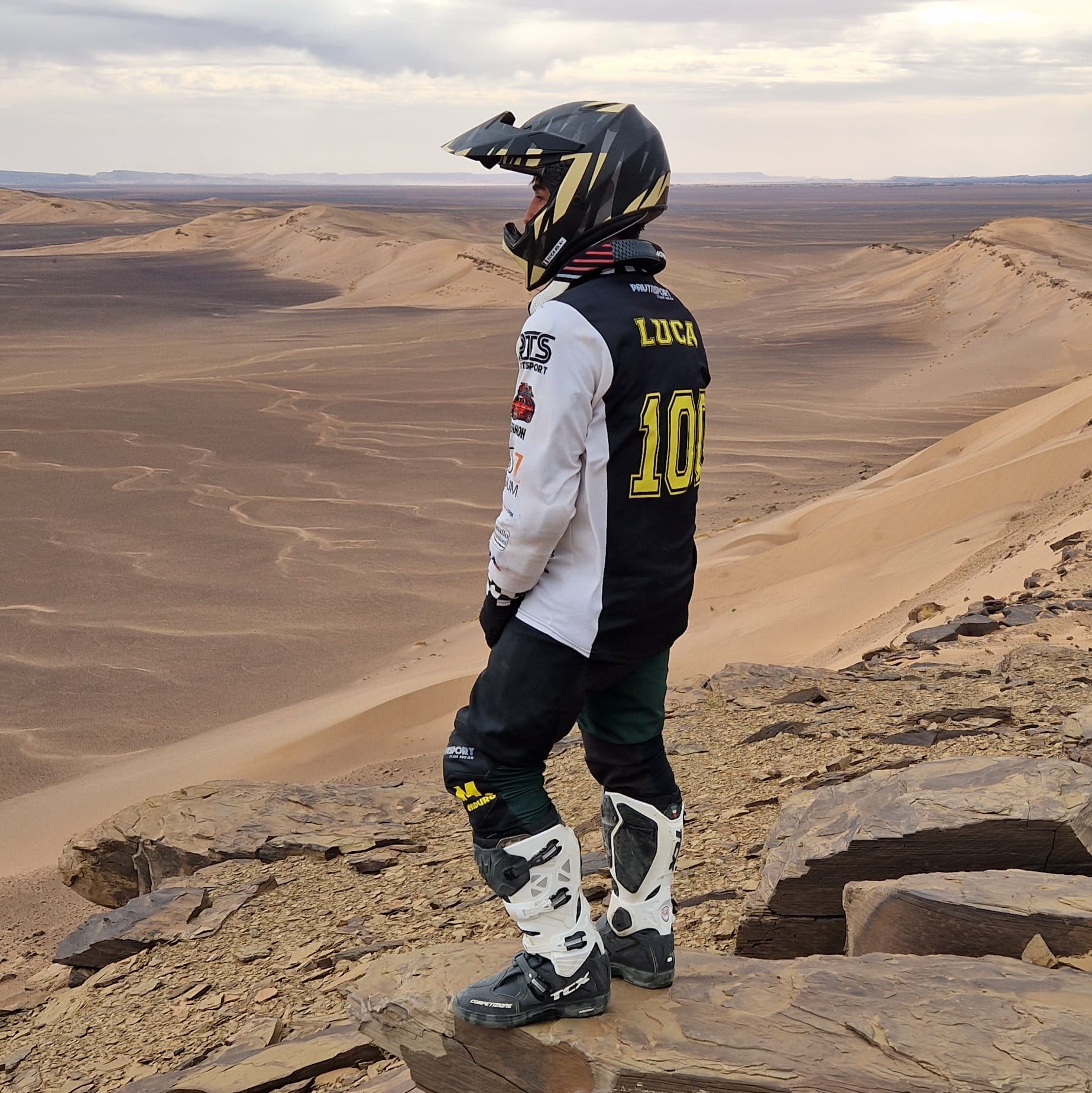
Born in 1976, I’ve been riding motorcycles since I was 14 years old. I traveled the roads of Italy all my life, on sports and supersports motorcycles, until, in 2020, some friends had me experience a moto rally. From that moment on, the appeal to visit destinations unreachable on road motorcycles has rapidly intensified, becoming an integral part of my life. It perfectly combines with my other passion: The mountain, in all its shapes and sizes, as well as exploring the remotest regions on the planet.
“Attention please, boarding for the Royal Air Maroc to Casablanca flight will begin shortly, passengers are requested to have their boarding pass and identification ready.”
It’s already been a year since that call to my friend Pietro, when I told him I wanted to fulfill and live a dream that, since I was a child, was with me every time I watched the deeds of those heroes who rode, for days, across empty expanses: That dream called desert.
The phone call lasted only a few seconds, enough time for him to reply, “I’m packed already, who’s coming with us?” I answered in a flash, as I’d already contacted a coordinator from the Avventure nel Mondo travel agency, who put me in touch with a guide who takes adventurous motorcycle riders wandering through the Moroccan desert.
“Frodo, listen, me and my friend can guarantee you that as soon as activities resume in October we’ll be your first customers; we’re booking, see you in October!” Who’s Frodo? Frodo is the Guide, with a capital G. I’ll tell you more about him later on, as I believe that people like him are one in a million.

Let’s get back to the trip. Once left Malpensa airport and having joined the rest of the group in Casablanca, we board a second flight to Ouarzazate. We’re eleven, and a well-assorted bunch: There are Antonio and Giorgio, two brothers from Genoa; Leonardo and Massimiliano, real characters from Tuscany; Andrea and Marco from Veneto; Emanuele from Milan; Giampiero from Emilia-Romagna; and finally our coordinator, the able Ruggero. Basically, it sounds like one of those jokes about regional types, but Pietro and I soon realized how lucky we were to end up in this group.
Ouarzazate, also called the “Gateway to the desert”, is a town that, with its lovely historic area – excellently kept, fortunately – and the now abandoned movie sets, opens the way into the Dades Valley where the river, over thousands of years, has carved an actual canyon. Stunning reddish rock that in the hours before sunset takes on a unique hue.
We arrive at the hotel late at night and immediately go to bed, a few hours’ sleep and we’ll have to get up and begin our adventure. After breakfast, with Moroccan mint tea (which we’ll drink throughout the trip, without fail, on every break and at any time of the day), msemen (a kind of bread product that vaguely resembles crepes), honey and jam, we get dressed like Dakar professionals and then walk to the agency’s headquarters. We’re all perfectly attired except poor Giorgio, who’s lost his luggage and has to make do with the assorted spare equipment each one of us can lend him.
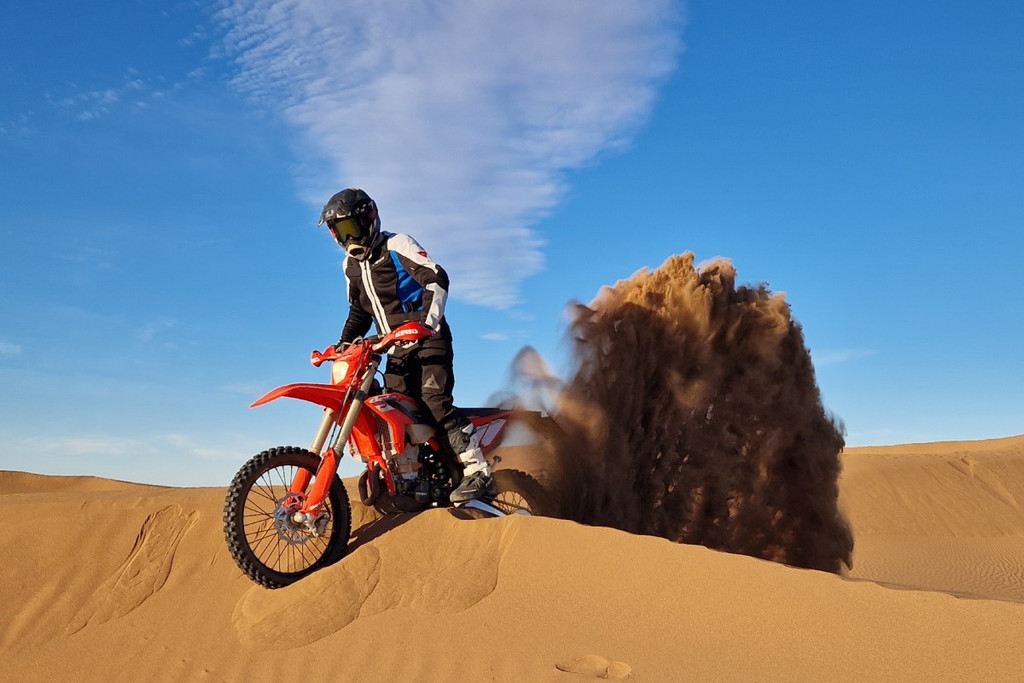
The streets of Ouarzazate are hectic and bustling: Wrecked mopeds, battered old cars, people on foot with carts and animals... Like a time machine, the flight took us at least 50 years back in time. And then there are the smells in the alleys – the scents, actually... Though not exactly as defined in the dictionary. It’s a scent that gets inside you and plunges you into a dream, a dream that’s becoming true and that I’m really starting to live.
Twelve brand-new Beta 390 enduro motorcycles are waiting for us here, together with him, Frodo, our guide. His reputation precedes him: A typical Tuscan man, not very tall, with wild hair and beard, skin as thick as a boar and a huge heart. Actually, I’m quite sure that in a fight he’d win and the boar would end up on the spit. He’s about forty years old and has been crossing the world’s deserts since he was twenty. Basically, he’s our insurance.
Unfortunately, the road that leaves Ouarzazate is now entirely paved; it’s like riding on one of those endless stretches across the American deserts you see in the movies, where the horizon stretches as far as the eye can see. But, in my mind, I keep on wondering, “When do we get to the dunes, come on, when do we get to the dunes?” There – suddenly, Frodo stands up on the pegs and turns right, off road. I was told that Morocco was rather rocky, and indeed we immediately start a wild indigenous Maori-style dance amid rocks of all kinds and sizes.
I’m thrilled, because I’m getting a first glimpse of what I’ll experience in the next few days: I’m actually on those typical rugged, rocky mountains and narrow, speedy paths I’d always only seen in travel documentaries. The road is very damaged and rocky, it feels as if it’ll never end and it’s really putting us to the test, the route is moderately challenging but the pace is surprisingly fast; we ride as one and not even the obligatory photo break disrupts our good pace. After all, we’re tourists, and this isn’t a special stage: We enjoy the unique, breathtaking views that Morocco has to offer.
It’s not too hot; the temperature is about 30 °C but the pace, the emotion and the focus required (you really have to be careful where you put your wheels) mean that I have to stop and take off my jacket. Choosing the attire for this trip in Morocco has been difficult, considering the desert’s well-known temperature variation. After discussing it with my travel companions, I finally decided to wear a classic adventouring outfit:
Moreover, to keep up the energy, I brought a backpack with water bag, electrolytes, energy gels and various bars (all choices that, in the end, turned out to be perfect).
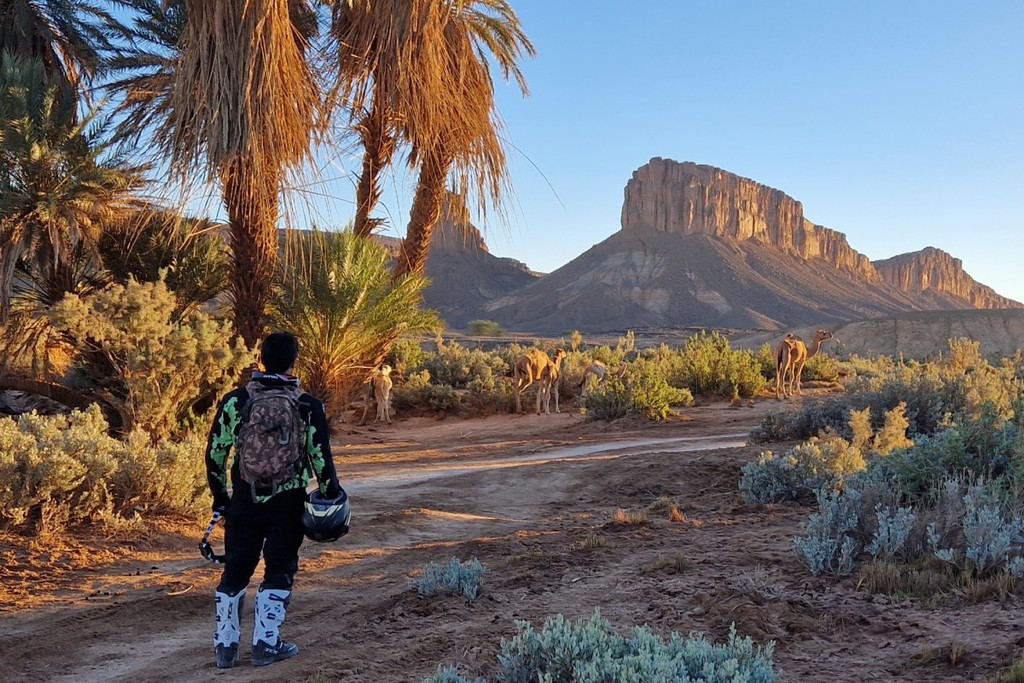
The beauty I’m starting to see is disarming: Villages in the middle of nowhere, palm groves, dusty paths climbing up and down the reddish mountains; we cross and stop in a village where life seems to have frozen half a century ago. It’s full of food hawkers, people sitting at tables dressed as in the olden days, drinking tea and eating dates, immersed in a setting that not even the best movie set designers would be able to replicate.
The three jeeps driven by locals, following us to provide assistance, transport our luggage and all that’s needed to set up the various bivouacs, have stopped under a palm tree: That’s where they set up our table – the first impromptu restaurant of the holiday. Impromptu perhaps, but of ten-star quality. Three camping tables, camping chairs and assorted provisions. Man, what a treat! All the food is cooked on the spot on two camping stoves, and it’s excellent. They give us a little of everything, from mixed salad to tinned sardines, from pasta to fruit. Everything’s delicious, and in this setting even more so.
Some chitchat, a very short nap and it’s time to move on: Our destination for the evening is our first campsite at Foum Zguid. The path is still very rocky and there’s still no sign of dunes, but I don’t mind as I feel as if I were on the moon, the landscape is already truly magical as it is. Then a herd of dromedaries comes out from behind an oasis, reminding me I’m actually in Morocco.
We reach the campsite. The small two-people tents and the two larger tents – kitchen and “dining room” – have already been pitched, just as it’ll happen every following night. We’re even welcomed with an excellent aperitif consisting of tea, cookies and popcorn. Finding everything ready every time is a real luxury, especially if I think about my Dakar heroes who race in ‘Malle Moto style’ and, after reaching each stage, have to service their motorcycles themselves before getting a chance to rest.
The king among Moroccan dishes – shown off in its various fish, lamb, beef, chicken and vegetarian variants – is the tagine, a single course slowly cooked in a closed earthenware pot. It’s going to be the star of our dinners throughout the trip, together with eggs and olives – eggs and olives everywhere and in abundance, even for breakfast.
The sun regales us with a multicolored sunset as it dips behind the mountains eroded by time, shining on the dromedaries that observe us with curiosity. The dinner is excellent and the laughs, the tales of the day and the sky bursting with stars make it all perfect. What was our everyday life fades in the distance: The Moroccan desert is stealing our souls.

We’re entering the Draa Valley: We’re at the gateway of the Sahara! I’m thrilled – we’re riding along those same trails taken by the heroes who inspired me to go on this trip; we cross Iriki, a dry lake, as well as endless desert-like spaces. We look like running gazelles quickly scattering through the savanna – some to the right, some to the left – as we look at each other. The real challenge consists in not keeping the wrist constantly up, as the smallest rock hidden in the sand could really send us flying to the Moon.
“Everything’s beautiful Frodo, but I want the dunes!” “
Be patient, we’re getting there.”
Erg Chigaga, a giant erg in the middle of nowhere, is an area full of dunes that, to us newbies, appears enormous (Frodo assures us these are “little ones”, no higher than 100 meters – I dare not imagine what a big dune might look like, at 500 or more meters high). He starts “dancing” with his motorcycle, leaving tracks just like a skier does when going off piste in fresh snow. I’m here, I’m here too, I’m dancing too; I don’t know how to describe the feeling, but I hope that if I go to heaven it’ll feel like this. I’m laughing under my helmet, they I’m crying, then laughing again.
We all stop in a row on the ridge of a dune, we take off the helmet and become children again. We hug each other, shake hands and sit down to contemplate the vastness that opens up before us. I take the motorcycle and head toward the highest dune; I park, pressing down the front wheel on the ridge, and sit down close to the motorcycle to admire the endless ocean I always dreamed about. I start to cry. Perhaps, my companions are crying, too, or have cried out of happiness under their helmet: We’re no longer just guests in this trip, we’re the protagonists.
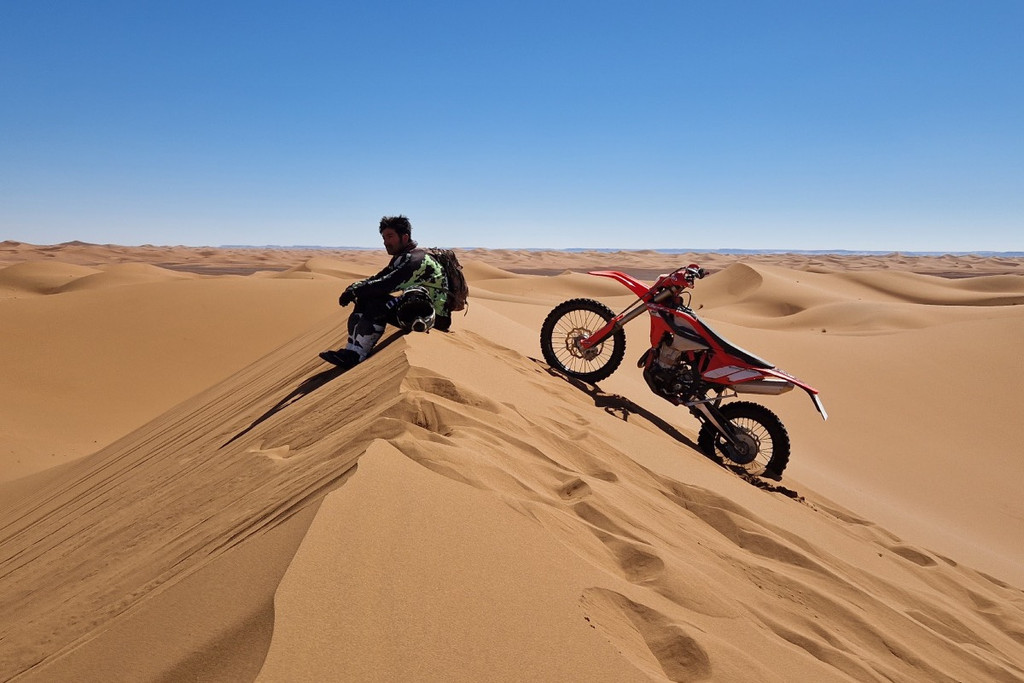
We resume dancing, but it’s not as easy as I thought it’d be; it’s not really because of the sand, rather, it’s trying to see where the dune ends. You really need to watch out or you could find yourself in thin air and plunge down tens of meters, with certain catastrophic consequences. This is why we – all of us and very carefully – follow our guide’s tracks to the new campsite.
We’re literally sleeping in the middle of the desert, amid the dunes; some people from the group decide to sleep outside the tent and enjoy a starry ceiling – so much for luxury hotels. Here, humidity is at a minimum, with a good sleeping bag you can easily spend the night without a roof over your head.
I’ve never seen a dawn like this: The sun, rising, shines a certain hue on these dunes and on this desert that I could never find or replicate again, not even with a Pantone color chart. I get dressed, take the motorcycle, go up the highest dune again and start filling my mind and eyes with a moment that I’ll never forget. The others arrive, too, and in silence we watch, and look at each other, amazed and full of feelings that are turning us into a single entity, we’re all connected even if we met each other only a few days ago.
We head toward the M’Hamid Oasis and, after some more dunes, the landscape starts changing, blending in with rock formations and sandy stretches: It’s fech-fech time. Fech-fech is a powder caused by the erosion of clay-limestone terrain, dangerous for motor vehicles as they can easily sink down into it. Constant speed, relaxed arms, and the fun begins. It’s like riding on an endless single track with bends, supports, jumps and chicanes, all in the middle of nowhere... what a treat! I wish it’d never end.
From Sidi Ali, we ride on toward Ramlia and Ouzina; what continues to really impress me is that houses materialize out of thin air – even if calling them ‘houses’ is often an overstatement; villages that are hours and hours away from civilization; often without water or electricity – but there are children. Yes, those children who have nothing, who wander barefoot and in dirty, ragged clothes, who don’t even enjoy a tiny part of the comforts we have – those children who, every time they hear us coming from afar, you see them running wildly amid dirt and rocks just to say hello or high-five us or ask us to do a wheelie.
I didn’t let any of them down: I’d slow down and, reaching out my hand, would high-five them or do a wheelie. I remember that when I was little, I used to ask motorcycle riders to do the same, and sports car drivers to rev up the engine, and when they wouldn’t, I’d feel sad. I’m giving them an extra smile and something they can boast of with their peers for at least that whole day.
We reach Merzouga rather early; we have time to drink a cup of tea or a Coke in a place where they’re playing traditional music with drums, also because we have to wait for the afternoon before entering paradise. Erg Chebbi, close to Merzouga, is famous because all professional riders come here to train: The dunes are massive and the area is vast, but not too much. It’s like a playground – this erg seems to have been built just for us off-road enthusiasts; From end to end it’s not too wide but big enough to have fun, and I imagine that in case of any problems you could reach civilization without too much trouble.
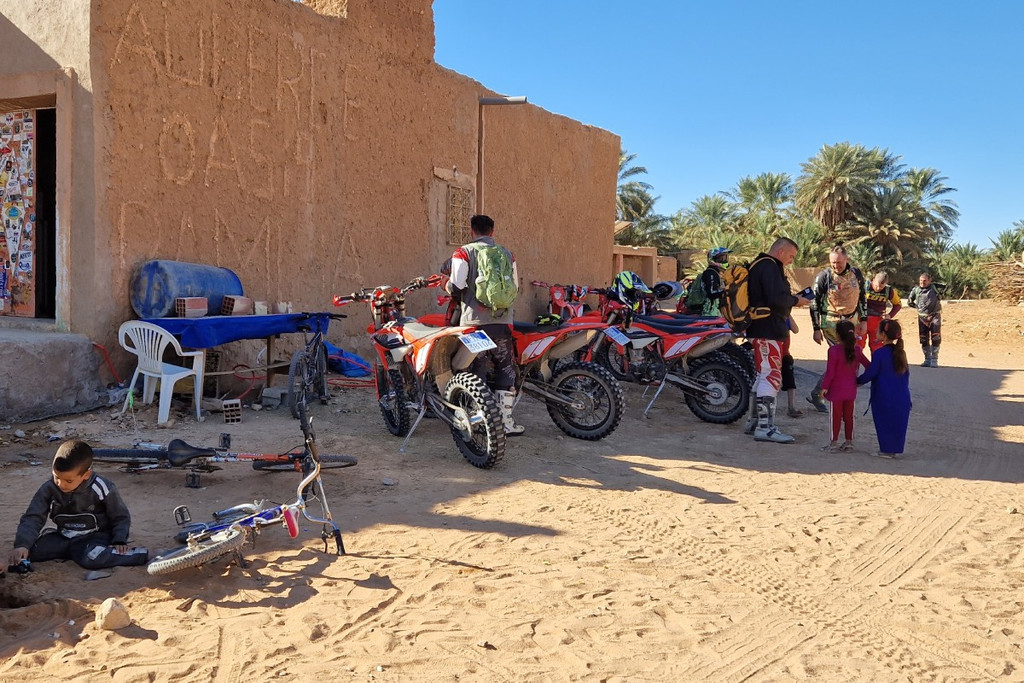
We go inside it and Frodo starts dancing again. It’s like being on a roller coaster, the motorcycle defies gravity, unbelievably taking me to the top of the dune on sandy slopes I’m not used to. We feel like desert marauders and, overtaken by enthusiasm and the desire to experiment, there’s no shortage of falls and highly embarrassing situations. The dunes are not at all friendly and have left their mark on some of us, on the ribs too, but we’re motorcycle riders and stoically endure the pain, or maybe just wave it off with “Not even a scratch”; we all call it a day and go back to the campsite, feeling like heroes. Here, our angels have set everything up, as usual. We light a fire and feel like real Bedouins.
We continue our adventure in the Moroccan desert by heading toward Tourza: Now, the landscape frequently changes; winding rocky roads take us up and down arid mountains; passes where, at times, we meet lonely travelers who’ll have to walk for days and days before reaching even just the semblance of civilization. We cross dusty villages with mud houses, and palm groves that are luxuriant thanks to small irrigation canals, which also allow for agricultural cultivation, and where the only modern and well-kept building is the mosque.
The climb to the high Atlas Mountains begin and our guide noticeably accelerates; he’s understood that our group likes speed, so the climb almost becomes a Pikes Peak race. I’m laughing under the helmet because scuffles always puts a huge smile on my face.
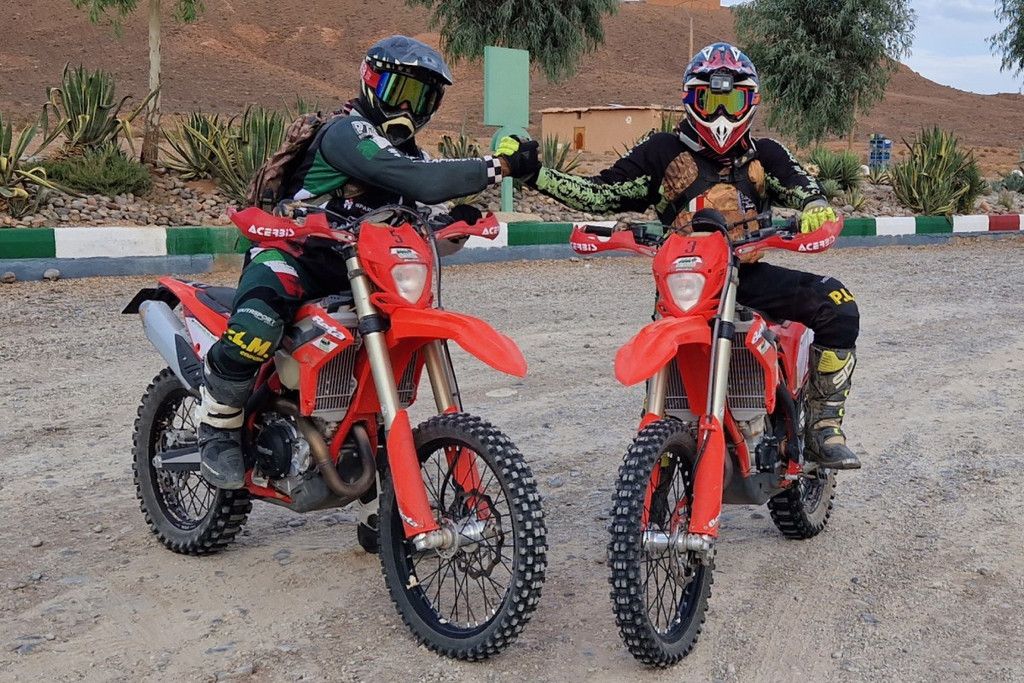
Fortunately, we all reach Ikniouen unscathed, at the foot of the great Jbel Saghro that, at 2,595 meters high, marks the eastern border; we stop for the usual cup of mint tea and Coke and, as always, we’re surrounded by curious people and children. Here, however, the people seem really different from those we met until now: In terms of appearance, their eyes are bigger and much closer together, their skin shows the typical mountain tan and they’re much less pushy – actually, they’re not pushy at all. They kind of remind me of some Nepalese people I had the good fortune to meet.
Our trip in Morocco is about to end: We head toward the Dades Valley riding on what is perhaps the most beautiful asphalt road in the world, with villages perched on hillsides that perfectly blend in with the brown hue of the earth, in contrast with the lush greenery and the blue waters at their foot. We cross the Valley of the Roses, where the “famous rose water” is distilled, and then we continue ahead, still on asphalt, toward Ouarzazate, our starting point.
Eight days have passed. Eight days, during which my eyes, my heart, my mind, all have filled up with lasting emotions, colors, images, memories. The real stroke of luck, however, was the chance to share all this with a tight-knit, though assorted, group – we all closely bonded with each other and this turned the trip into a real adventure. A journey, after all, doesn’t begin when we set off, nor does it end when we reach our destination. It begins much earlier and never ends, as our tape of memories continues to run in our heads long after we’ve stopped. It’s the traveling bug, a well-known disease for which there is still no cure. Perhaps, for me, this disease has now turned into a longing for Africa.